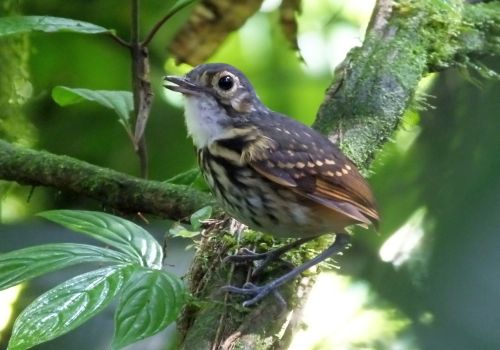Antpittas are most often affiliated with the cloud forests of the avian rich Andes. It makes sense, those fantastic habitats of bird aficionado dreams are where most people see their first antpitta. In the past, as wonderfully birdy as those places are, except for birders wielding a good deal of time, patience, and determination, many an antpitta stayed safely put in the “heard only” category.
That tantalizing dynamic was changed by feeding stations and similar situations. Once they hit the birding scene, Giant Antpittas, Yellow-breasted Antpitta, even the previously near mythical Moustached Antpitta started showing up on trip reports and bird lists that featured satisfied antpitta checks in the “seen!” column. Worm feeding stations in Ecuador and Colombia quickly became the easiest way to see antpittas and in the subsequent years since they became established, they have helped thousands of people test their close focus on antpittas.
These special feathered gnomes reach their greatest diversity in the Andes but they also live in other, hotter places. In the absence of feeding stations, antpittas of the lowland and foothill forests continue to be some of the more difficult birds to see. Like their montane cousins, most are readily heard but unlike some birds in the mountains, they haven’t adopted the way of the fed worm. Who knows, maybe lowland ntpittas would comply if more people tried to make that happen but until then, most situations for such species as the Thrushlike, Spotted, and Speckled-breasted Antpittas will require old fashioned antpitta viewing factors like stealth, determination, and good fortune.

Those and other attributes are needed to see the lowland antpittas that are two of many cherished birds in Costa Rica. Here are some ideas for laying eyes on these prize birds:
Streak-chested Antpitta
Fortunately, in Costa Rica, we have one or two reliable sites to connect with this cool little bird. Go to Carara National Park, especially as soon as the park opens, walk the Quebrada Bonita loop trail, and you should hear its sad whistled song. Invest the time in looking and waiting for the bird and you also have an excellent chance of seeing it. It’s worth keeping a careful eye on the trail as far ahead as you can see, I have noticed this stealthy little ball of feathers hop across and into view on more than one occasion.

They can also show at the edges of antswarms but most birders find them by listening for their haunting whistled song. As with other shy forest birds, a key way to see one is by carefully scanning the forest floor and patiently waiting for one to reveal itself. That typically happens when one hops into view but they can also get noticed when they puff their chest feathers in and out. That body inflation isn’t the most obvious motion in the forest but is another reminder to check out any percieved movement, event the hint of one. I recall seeing more than one Streak-chested Antpitta as well as other birds being attuned to such forest hints.
For the Pacific race of this species, Carara is the most accessible spot but they also occur in other forested sites, especially flat areas with tall forest in the Osa Peninsula.
As for the Caribbean slope version of the Streak-chested Antpitta, listen and look for it in the same way at Quebada Gonzalez, deep in La Selva, and other sites with extensive primary forest. It doesn’t seem to readily occur at Arenal but with lowland species moving upslope, this might change. It’s also worth mentioning that ideally, a Costa Rica birding tour should try and see this bird on both sides of the mountain because there’s a fair chance two species are involved.

Thicket Antpitta
This vocal skulker is Costa Rica’s other lowland antpitta. Since it might be more at home in the foothills and occurs in second growth, Foothill Antpitta or S and G Antpitta might be more appropriate but in any case, “Thicket” still works.
This secretive bird isn’t shy with its vocal chords. Over and over, it teases with its rising whistled song. A good thing too because otherwise, you would never see the thing. It absolutely loves wet and thick second growth and can occur anywhere in the Caribbean lowlands but may be most frequent in the Tilaran Mountains. That would mostly be the Arenal area. Go birding on the Peninsula Road or various other spots and you will probably hear it. To see it, find a spot near a singing bird where you can actually see the ground and play the patience game.
Other very good sites for this species include Tierras Enamoradas and Pocosol.

It’s worth mentioning that this bird could also end up being a species separate from the ones that live in South America. Maybe, maybe not but there’s nothing wrong with seeing more antpittas.
These are the lowland antpittas of Costa Rica. Birds worth seeing but birds that also require patience, stealth, and determination. A good guide and birding tour in Costa Rica can also make the difference. Speaking of that, I know of a tour available for an excellent price that has one spot open for a woman (sharing a room with another woman). The tour is scheduled in January, 2022 and because of a cancellation, that one spot to see Streak-chested Antpitta and hundreds of other species is available.
Various key sites will be visited including Poas, Sarapiqui, Cope’s, Cano Negro, Arenal, and Carara. Last year, a similar tour saw more than 425 species during 10 days of fantastic birding. If interested or know someone who would love to experience a wealth of tropical birds and close looks at macaws, toucans, tanagers, hummingbirds, and many other birds in Costa Rica, please contact me today at information@birdingcraft.com
As always, I hope to see you birding in fantastic Costa Rica. It’s closer and easier than you think!

